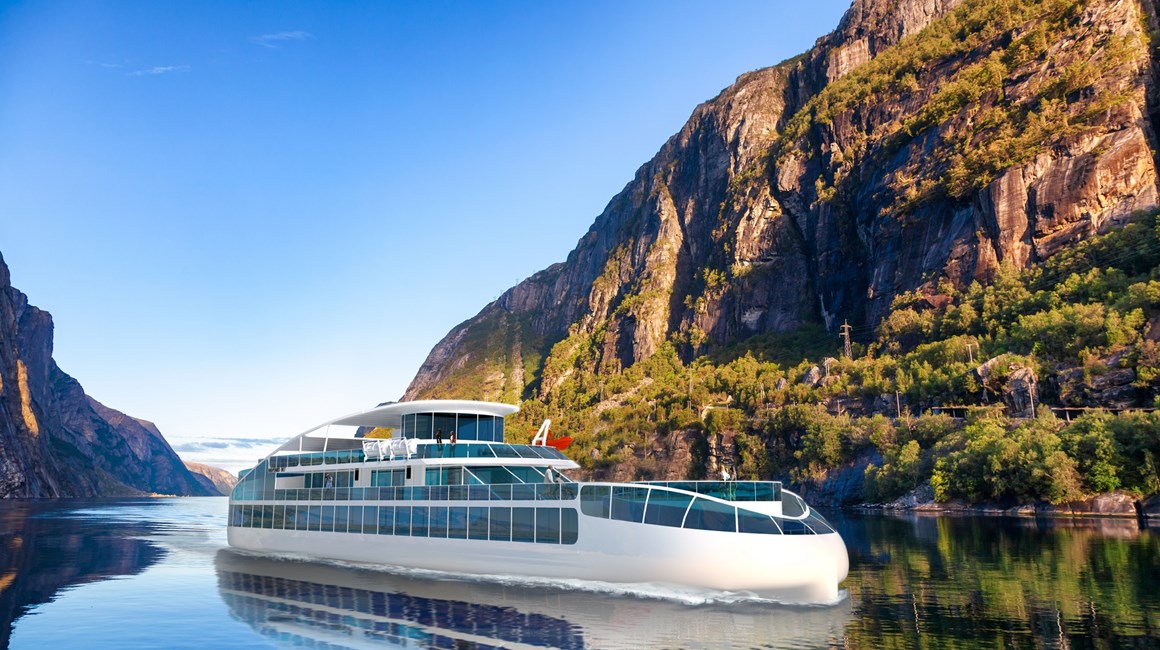Emissions from the shipping traffic is a big challenge both in bigger cities and in fjords with many cruise ships. Havyard has designed a zero-emission sightseeing vessel, which may solve this problem in future.

Collaboration, research and development
Havyard Design & Solutions constitutes an expert environment for smart ship design and energy-efficient ships, and our design department has since 2005 researched and tested new designs and solutions for a wide variety of vessels.
In July 2019, Havyard entered into a collaboration with SINTEF to investigate new solutions for a more environmentally friendly shipping industry. This is an important project that builds on a development process Havyard has been engaged in for the past decade, as well as research conducted in cooperation with SINTEF at the R&D centre SFI Smart Maritime. We already have tools to measure energy consumption by calculating the realistic operational profile and environmental impact, which allow us to choose optimal solutions for hull, equipment and energy sources. This methodical approach, which can be applied to all types of vessels, enables Havyard to calculate and make commitments regarding realistic emission values in tenders for ferries, the Kystruten coastal route and other types of vessels.
Passenger experience
Havyard is a pioneer in the design and construction of zero-emission ferries and draws upon this experience in its new city and fjord sightseeing concept. These ships are developed on the basis of our knowledge about battery-operation and charging, and can meet big cruise ships outside of the World Heritage areas and the cities and bring the passengers to the innermost parts of the fjords and into the city centres. The ships will be 70 meters long, have a capacity of 600–800 passengers, run at 10–11 knots and offer a quiet, comfortable travel experience that matches the experience of the scenery which is the purpose of the trip.
In addition to the no-emissions aspect, the design focuses on the passenger experience with spacious areas inside and out, big windows that allow the passengers to take in as much as possible, and, finally, a universal design allowing wheelchair users to move freely around the ship.
Designer Stig Magne Espeseth has designed and developed the new zero-emission sightseeing vessel. He finds it very exciting to base this concept on his experience from designing ferries.
'Some of the most important criteria when designing vessels are safety, low energy consumption, cost efficiency and functionality, but for us as designers, aesthetics and the design process are also important criteria. In our new concept, there are a few new elements that we need to take into account. One example is that there will be many people in a limited area, which means that there is a need for lots of space. How, then, can we give everyone a "front row view" so that they can see as much as possible of our beautiful fjords and cities and at the same time ensure their safety and comfort both indoors and out? In my opinion, our new design proposes a good solution to this.'
Floating hubs
The passengers will be transferred on a floating hub installed at the mouth of the fjords and outside of the cities where the cruise ships call. These hubs will also serve as charging stations for the mini cruise vessels. A potential limited capacity of the grid can be overcome by connecting battery packs to the grid. This way, the load on the grid will be constant, and at the same time, the mini cruise vessels will have enough charging voltage. If the mini cruise vessels are charged during the night, they can use power from shore at the hub during their stay at daytime, thereby contributing to further emission reductions.
'With this concept, we want to demonstrate that it is possible to create new solutions to complex challenges. Zero emissions and sustainable transport will be an integrated part of the experience when passengers are going into vulnerable areas,' Espeseth says.
Source: Havyard